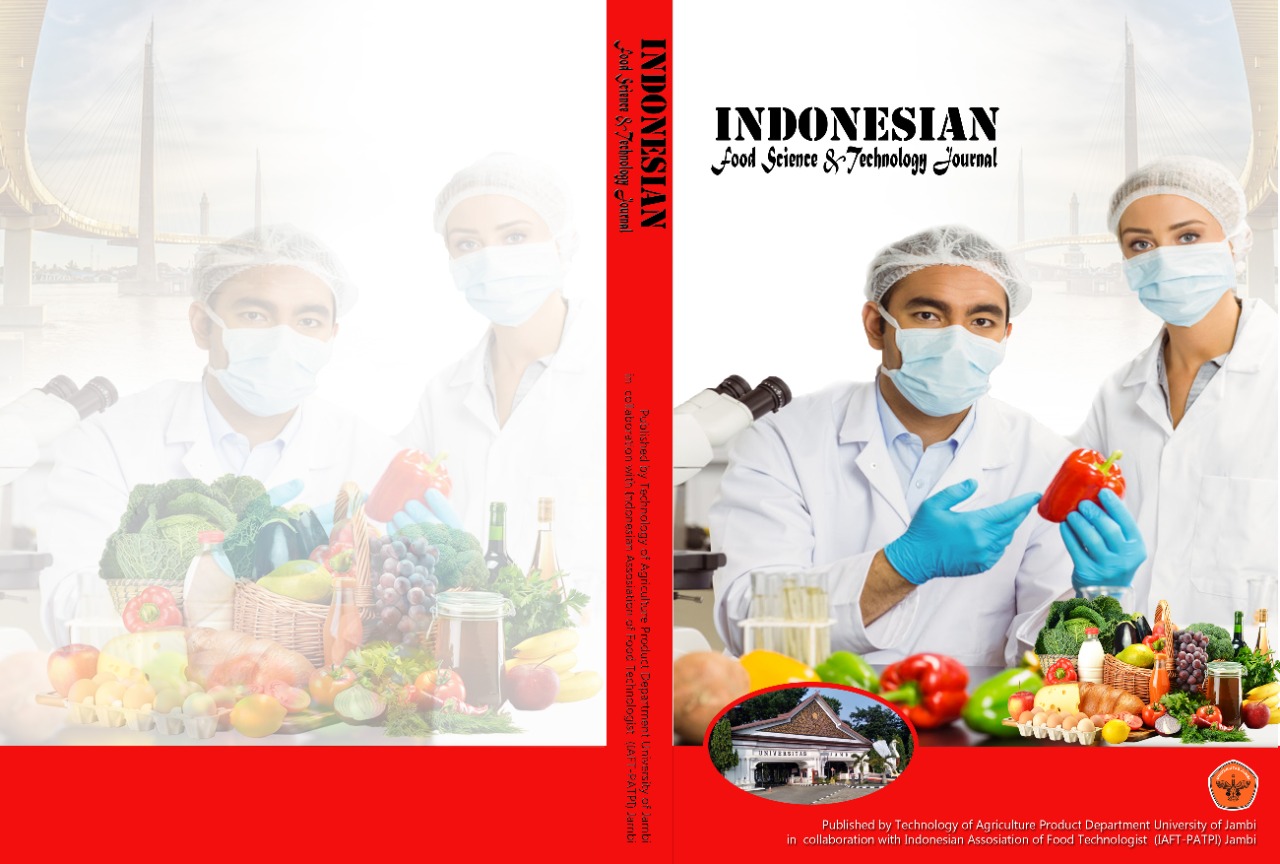Effect of different extraction methods on antioxidant and sensorial properties of pasteurized black soymilk
DOI:
https://doi.org/10.22437/ifstj.v7i1.30784Keywords:
antioxidants, anthocyanins, black soybean, phenolicAbstract
Abstract— The processing methods of black soymilk (BSM) can significantly affect the retention of its bioactive compounds. The effect of cold water (4 ℃, 8 hr) (CWE), hot water (80 ℃, 10 min) (HWE) and alkali water extraction (0.25% NaHCO3, 54 ℃, 10 min) (AWE) of BSM on antioxidant and sensory properties of pasteurized BSM (72 ℃ /10 min) was evaluated over 10 days of storage at 4 ℃. A steep increase in the total phenolic content (TPC) of BSM from HWE was observed over 10 days of storage, although the TPC of that from AWE was steadily the highest. The trend of flavonoids of BSM from HWE was the same as that for TPC, achieving a concentration of 1858.77 mg QAE/100 g after 10 days. The total anthocyanin content was the highest (40.85 mg/100 g) in BSM by HWE at the end of storage. Although the TPC of BSM from all extraction methods increased during storage, the total anthocyanin content showed a decreasing trend. Overall, the DPPH radical scavenging activity of BSM by HWE increased during storage up to 32.19 % on day 10 and a decreasing trend was observed from AWE and CWE. Triangle test showed that there was a significant (p<0.05) sensorial difference among the three extraction methods. The BSM from AWE had the highest score in the 9-hedonic scale for all sensorial parameters after the commercial BSM. Overall, the heat treatment in both HWE and AWE enhanced the antioxidant activity and sensory properties of pasteurized BSM, respectively.
Downloads
References
Josipovic, A., Sudar, R., Sudaric, A., Jurkovic, V., Kocar, M. M., and Kulunzic, A.M. (2016). Total phenolic and total flavonoid content variability of soybean genotypes in eastern Croatia. Journal Food Science technology, 8(2). 60-65.
Harlen, W. C, and Jati, I. R. A. P. (2018). Antioxidant activity of anthocyanins in common legume grains. Polyphenols: Mechanisms of Action in Human Health and Disease, 8, 81-92.
Koh, K., Youn, J. E., and Kim, H. S. (2011). Identification of anthocyanins in black soybean (Glycine max (L.) Merr) varieties. Journal Food Science Technology, 51(2), 377-381.
Lee, J., Barners, K. W., Eisele, Giusti, Hache, J., Hofsommer, H., Koswig, S., Krueger, D.A., Kupina, S., Martin, S. K., Martinsen, B. K., Miller, T. C., Paquette, F., Ryabkova, A., Trenn, U., and Wightman, J. D. (2005). Determination of total monomeric anthocyanins pigment content of fruit juices, beverages, natural colorants, and wines by the ph differential method: collaborative study. Journal of AOAC International, 5, 88.
Esteves, T. C. F., Felberg, I., Calado, V. M. A., and Carrao-Panizzi, M. C. (2017). Effect of black soymilk processing conditions on anthocyanins content. Journal of Environmental Science, Toxicology and Food Technology, 11(2), 56-60.
Ivanoic, J., Tadic, V., Dimitrijevic, S., Stamenic, M., Petrobic, S., and Zizovic, I. (2014). Antioxidant properties of the anthocyanin-containing ultrasonic extract from blackberry cultivar “ˇCacanska Bestrnaâ€. Industrial Crops and Products, 53, 274-281.
Azalina, F. A. A. and Mohammad, I. (2013). Antioxidant activity and phytochemical composition of Cynometra cauliflora. Journal of Experimental and Integrative Medicine, 3(4):337-341.
Chugh, A., Khanal, D., Walkling-Ribeiro, M., Corredig, M., Duizer, L., and Griffiths, M. W. (2014). Change in colour and volatile compositions of skim milk processed with pulsed electric field and microfiltration treatments or heat pasteurization. Foods, 3(2), 250-268.
Juan, M. Y., and Chou, C. C. (2010). Enhancement of antioxidant activity, total phenolic and flavonoid content of black soybeans by solid state fermentation with Bacillus Subtilis BCRC14715. Food Microbiology, 27, 586-591.
Nurhidayah M. A. (2010). Study of antioxidant properties and physical stability in different storage conditions and times of Cymbogon citrstus (Lemongrass). Journal of science, 28-30.
Qin, P., Wei, A., Zhao, D., Yao, Y., Yang, X., Dun, B., and Ren, G. (2017). Low concentration of sodium bicarbonate improves the bioactive compound levels and antioxidant and α-glucosidase inhibitory activities of tartary buckwheat sprouts. Food Chemistry, 224, 124–130
Zhou, R., Cai, W., & Xu, B. (2017). Phytochemical profiles of black and yellow soybeans as affected by roasting. International Journal of Food Properties, 20(12), 3179–3190.
Park, C. Y., Lee, K.-Y., Gul, K., Rehman, M. S., Kim, A.-N., Chun, J., Choi, S.-G. (2019). Phenolics and antioxidant activity of aqueous turmeric extracts as affected by heating temperature and time. LWT.
Sharma, K., Ko, E. Y., Assefa, A. D., Ha, S., Nile, S. H., Lee, E. T., and Park, S. W. (2015). Temperature-dependent studies on the total phenolics, flavonoids, antioxidant activities, and sugar content in six onion varieties. Journal of Food and Drug Analysis, 23(2), 243–252.
Socha, R., Juszczak, L., Pietrzyk, S., and Fortuna, T. (2009). Antioxidant activity and phenolic composition of herb honeys. Food Chemistry, 113(2), 568–574.
Sarkis, J. R., Jaeschke, D. P., Tessaro, I. C., and Marczak, L. D. F. (2013). Effects of ohmic and conventional heating on anthocyanin degradation during the processing of blueberry pulp. Food Science and Technology, 51(1), 79–85.
Patras, A., Brunton, N. P., O’Donnell, C., & Tiwari, B. K. (2010). Effect of thermal processing on anthocyanin stability in foods; mechanisms and kinetics of degradation. Trends in Food Science and Technology, 21(1), 3–11.
Å ibul, F., OrÄić, D., Vasić, M., AnaÄkov, G., NaÄ‘pal, J., Savić, A., & Mimica-Dukić, N. (2016). Phenolic profile, antioxidant and anti-inflammatory potential of herb and root extracts of seven selected legumes. Industrial Crops and Products, 83, 641–653.
Castro-López, C., Sánchez-Alejo, E. J., Saucedo-Pompa, S., Rojas, R., Aranda-Ruiz, J., & MartÃnez-Avila, G. C. G. (2016). Fluctuations in phenolic content, ascorbic acid and total carotenoids and antioxidant activity of fruit beverages during storage. Heliyon, 2(9), e00152.
Cheynier, V. (2012). Phenolic compounds: from plants to foods. Phytochemical, 11 (2-3), 157-177.
Kasım, R., Sülüşoğlu, M., and Ufuk, K. M. (2011). Relationship between total anthocyanin level and colour of natural cherry laurel (Prunus laurocerasus L.) fruits. African Journal of Plant Science, 5 (5), pp. 323-328.
Nyombaire G, M. Siddiq, K.D. Dolan (2011). Physico-chemical and sensory quality of extruded light red kidney bean (Phaseolus vulgaris L.) porridge LWT – Food Science and Technology, 44 (2011), pp. 1597-1602
Mian, K. S., Masood, S. B., Hafiz, R. S. and Muhammad, N. (2017). Sensory Evaluation and Consumer Acceptability. Journal of science, 14, 362-386.
Downloads
Published
How to Cite
Issue
Section
License
Copyright (c) 2023 Indonesian Food Science and Technology Journal

This work is licensed under a Creative Commons Attribution 4.0 International License.







